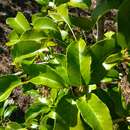Biology
(
英語
)
由Arkive提供
Whereas the common name used for the species, Portugal laurel, incorrectly implies that it is a variety of laurel (Lauraceae), the name given to the subspecies, Azores laurel cherry, paints a more accurate picture, recognising that it is in fact a type of cherry. Unlike other cherries, however, this plant is evergreen, resembling laurels. Further more, Portugal laurels do not bloom until after new leaves form in spring, whereas most cherries bloom before leafing (5). This tree's stunning white flowers blossom in June, have both male and female organs, and are pollinated by insects (3) (6). The flowers give way to green cherries that eventually ripen to a shiny black colour in autumn (5).
Conservation
(
英語
)
由Arkive提供
No conservation initiatives are currently in place for this subspecies.
Description
(
英語
)
由Arkive提供
This subspecies of Portugal laurel (Prunus lusitanica) is a hardy evergreen tree with larger, thicker leaves than the other subspecies, but with the same beautiful clusters of white scented flowers when in bloom. The leaves are reddish when young, but turn dark green when mature, while the stalks remain red (4).
Habitat
(
英語
)
由Arkive提供
Inhabits deep, narrow ravines and undisturbed laurel-juniper forests (1).
Range
(
英語
)
由Arkive提供
The tree is found on the islands of Sâo Miguel, Terceira, Sâo Jorge and Pico off Portugal (Azores) (1).
Status
(
英語
)
由Arkive提供
Classified as Endangered (EN B1 + 2ce) on the IUCN Red List 2004 (1), listed on Annex II of the European Habitats Directive and on Appendix 1 of the Convention on the Conservation of European Wildlife and Natural Habitats (3).
Threats
(
英語
)
由Arkive提供
The major threats to this subspecies are the clearance of trees for agriculture and plantations, and the competition and predation pressure posed by introduced animals and plants (1).

